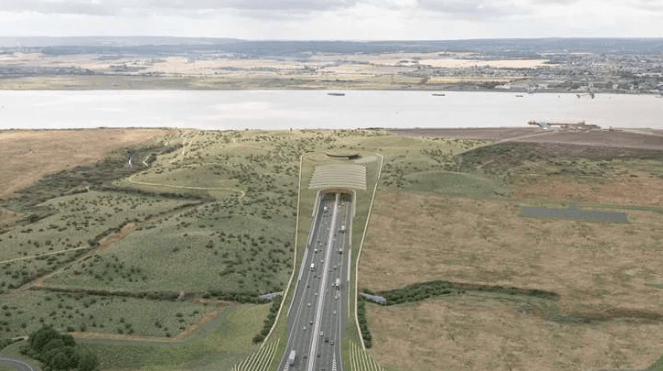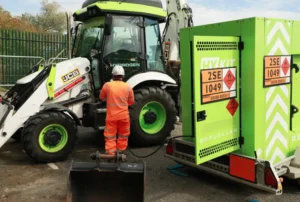The government has announced that a Development Consent Order for the Lower Thames Crossing project has been approved by the Secretary of State for Transport, Heidi Alexander MP.
Sir John Armitt, Chair of the National Infrastructure Commission, said:
“Improving connectivity is vital to the government’s mission of sustainable, long term economic growth. This green light for the Lower Thames Crossing is excellent news and will be welcomed not only by local drivers and communities but also by businesses across the country which depend upon reliable access to Europe, but are often frustrated by delays at the Dartford Tunnel.
“Given the scale of investment needed in the country’s strategic infrastructure over coming decades, I hope this is the first of many future strategic planning decisions which are crucial to transform the transport, energy and water networks on which the country relies.”
Reaction:
Cascade, the Technical Partner on the Lower Thames Crossing and who supported development of the Development Consent Order, have issued a statement regarding the Government’s decision earlier this week.
“We are delighted that the Lower Thames Crossing has received planning permission from the Secretary of State for Transport, Heidi Alexander MP on Tuesday 25 March. This pivotal decision marks a significant step forward in the government’s Plan for Change, to drive growth and enhance connectivity and infrastructure in the region.
“Jacobs, Arcadis, and COWI are proud to be contributing to National Highways vision for the Lower Thames Crossing. Together, we’ve played a key role in bringing this project to life – ensuring communities and stakeholders have a voice in shaping its future. As a pathfinder, the Lower Thames Crossing is looking for ways to accelerate change across construction. Our people have brought their expertise and passion to help National Highways fundamentally changing how we deliver strategically important infrastructure in the UK.
“It will alleviate the decades-long congestion that has acted as a handbrake on local growth and create significant opportunities for jobs and skills development within the local communities.
“We extend our thanks to all stakeholders involved in this process, and we look forward to the continued partnership with the government, local authorities, and communities as we embark on this exciting journey toward a more connected future.”
Kate Kenny, Executive Vice President Europe for Jacobs, said, “The news that the government has given the Lower Thames Crossing the green light is a huge moment for the region and the UK. This ambitious project will not only transform journeys and tackle long-standing barriers to opportunity, but will drive economic growth in a way that restores nature and leaves a legacy of local jobs and skills. We’re immensely proud of our role helping National Highways create a new modern blueprint for building inclusive, low-carbon projects, and look forward to supporting it as it moves into delivery.”
Paul Dennett, Arcadis Mobility Director UK & Ireland, said “This is a hugely significant milestone for this major project that has seen the very best of public and private sector collaboration to deliver on a scheme that has the potential to kickstart major economic growth.
“I am immensely proud of the expertise, dedication and commitment of our team, and the wide range of professional services we have provided, in order to get this Development Consent Order decision over the line. We look forward to continuing to work on Lower Thames Crossing as the project now moves into the delivery phase.”
Andy Sloan, Managing Director, COWI in the UK & Ireland said, “The Lower Thames Crossing is a transformative project that will enhance connectivity and provide much needed capacity for road users, across the Thames east of London, while establishing a new standard for sustainable infrastructure development in the UK.
“Investment into infrastructure, like the Lower Thames Crossing, are essential for unlocking the UK’s economic potential. By enhancing transport networks, promoting sustainable energy and improving infrastructure, we can foster innovation and create jobs, paving the way for a prosperous future that benefits communities across the UK. This decision comes after a rigorous examination from independent experts and I am extremely proud of our team who have worked tirelessly over the years to reach this momentous day.”
Essex County Council issued a largely positive statement on the potential impacts of the £10 billion scheme.
Councillor Louise McKinlay, Essex County Council Deputy Leader and Cabinet Member for Communities, Economic Growth and Prosperity, said:
“The Lower Thames Crossing project is clearly important to economic growth and prosperity, both in Essex and across the wider region, better connecting Essex with our neighbours in Kent, as well as London and the north, whilst at the same time helping to reduce congestion at the Dartford Crossing.
“The economic benefits of the new crossing will be huge; creating new job opportunities during the delivery phase, and unlocking significant growth across the region, but there will be impacts on local residents living near the construction site and as the project moves forward. We will work closely with National Highways to help mitigate the impacts, while ensuring the residents of Essex benefit from the opportunities this new infrastructure will bring.”
Cllr John Kent, Leader of Thurrock Council, had previously expressed concerns about the scheme’s effects on congestion:
“These current plans would do nothing to improve congestion locally or regionally and would add little capacity to the national strategic road network,” he said in October. “They would, however, cut Thurrock in two, severing communities, bring huge amounts of pollution to the borough, but bring no discernible benefits for local people. Given the government’s focus on the environment, surely this investment could be better made in greener forms of travel, such as improving our train network or investing in river transport.”
The crossing will reduce congestion on the Dartford Crossing with a new motorway-style road. However, it would cut through large swathes of Thurrock green belt and campaigners and cross party politicians have fought against it.
Following the announcement, Jen Craft Labour MP for Thurrock, told Your Harlow: “I am obviously disappointed by today’s decision. I still have concerns around the disruption this scheme will cause to local residents and the impact on air quality in the area.
“I fully recognise that congestion at the Dartford Crossing is causing misery for drivers, but building more roads is not the answer. I still believe that alternatives such as investment in cross river public transport would provide a more sustainable solution.”
Conservative Barry Johnson, shadow councillor for place and environment said he was “devastated and appalled” by the decision. He said: “This will not solve the issues around the Dartford Crossing, but will extend them throughout the whole of Thurrock. This is a disastrous decision for Thurrock, it will bulldoze our countryside, gridlock our roads, and pollute our air.”
Colette Carroll, Managing Director – Transportation, AtkinsRéalis UK & Ireland, said:
“This is a welcome decision to progress a vital infrastructure programme that will improve connectivity and deliver significant benefits to businesses across the country.
“Congestion at the Dartford Crossing currently costs our economy £200 million annually: the Lower Thames Crossing will not only ease this congestion but act as a new strategic economic corridor, creating new links between communities, businesses and major ports. It will also support thousands of jobs and develop critical skills for the future.
“As the Planning and Infrastructure Bill passes through Parliament to streamline critical national infrastructure projects, today’s announcement is an important recognition of the crucial role of infrastructure in delivering growth.”
Meawhile, Nick Fenton, business development service Locate in Kent’s CEO, said:
“We welcome the decision by the Secretary of State for Transport to give the go-ahead for the Lower Thames Crossing, a vital decision towards ensuring Kent and Medway, the UK’s gateway to Europe, has the capacity to keep traffic and freight moving.
“The Lower Thames Crossing will almost double road capacity across the Thames east of London – easing chronic congestion on the Dartford Crossing, improving journey times for businesses across the southeast, keeping freight passing through the Channel Ports and providing a huge economic boost to the UK. It will also deliver thousands of jobs during the construction phase, and beyond.
“This nationally important strategic route is vital for this country’s logistics network. Kent and Medway has a major role to play in supporting UK trade and investment and it was imperative that the project goes ahead.
“This new route is urgently needed, not least in supporting the government’s house building and growth agenda for the UK economy. Not going ahead would have sent an unwelcome signal to business and investors, that we’re not a country that invests for the long-term.
“Today’s decision to grant planning approval for the Lower Thames Crossing should also be a time for policy makers at all levels to reflects on what needs to be done to remove obstacles to delivering the infrastructure needed as a nation to deliver future growth.
“That includes pressing ahead with planning reform and further incentives that will attract investment to pay for further improvements, from widening the M2 to restoring international rail services to the county.”
(Pic: National Highways)






















